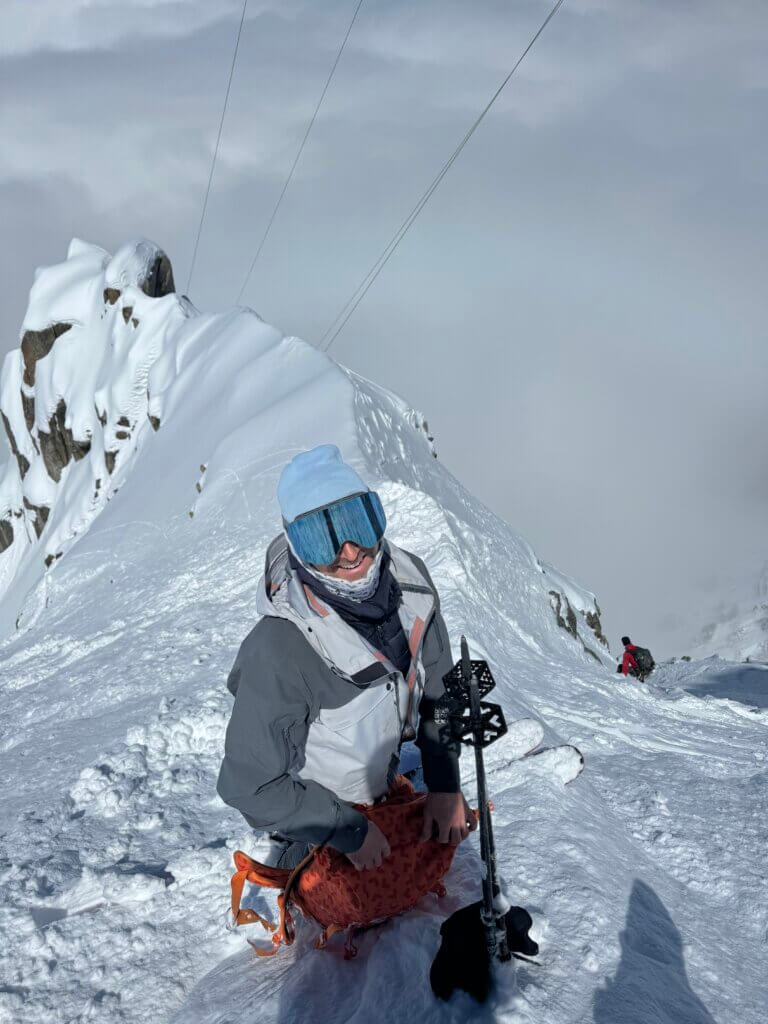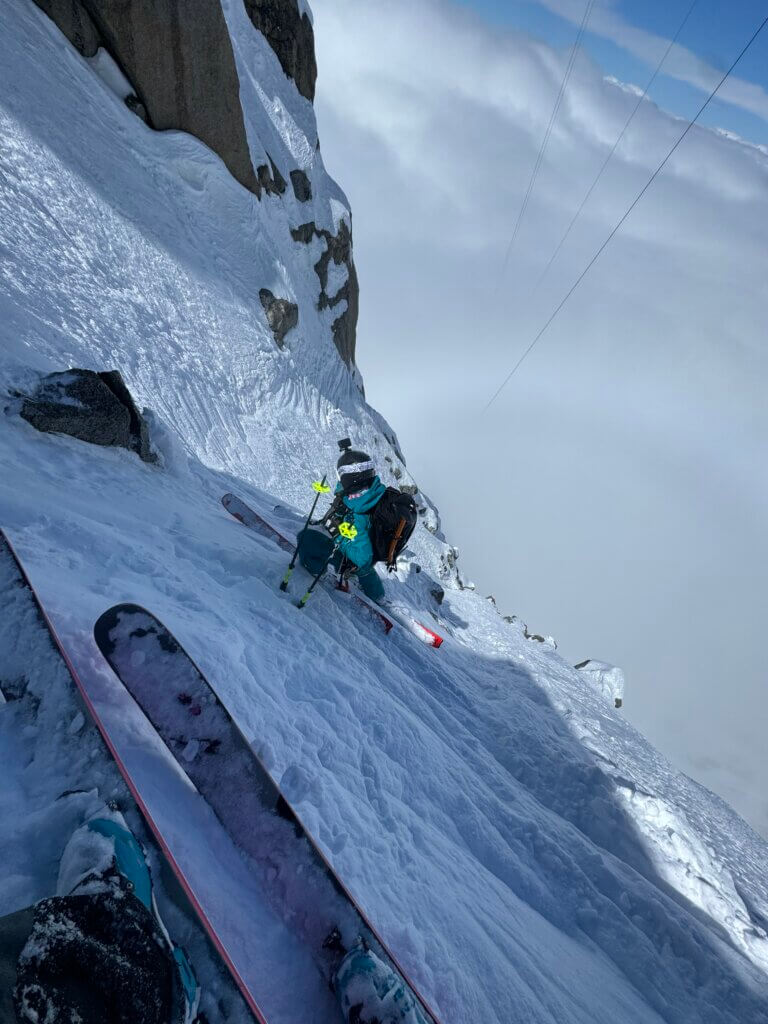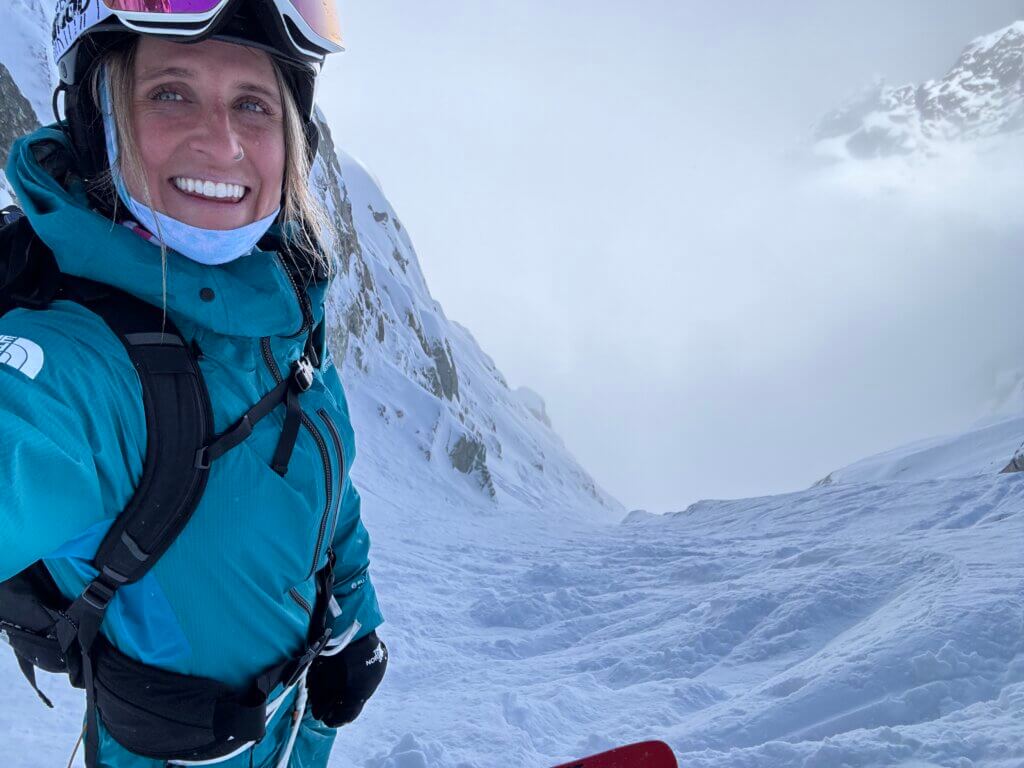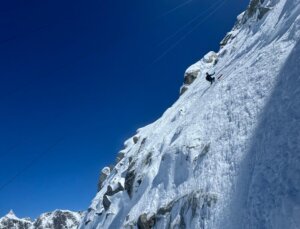Fay Manners gazes upon the imposing north face of the Aiguille du Midi, a silhouette that has dominated her view and ambitions since she moved to Chamonix in 2015. An alpinist by training, Manners has transformed into a skier, not merely traversing but mastering the steep lines once reserved for the boldest climbers. This year, she accomplished a feat that threads the needle between audacity and skill: skiing the storied Col du Plan and Mallory routes in a single day. “I’ve looked at the north face over 100 times,” Fay reflects, “dreaming of being competent enough to ski these extreme lines.” Her journey from climbing to skiing encapsulates a blend of rigorous preparation and profound respect for the mountain—qualities that have guided her through nearly a decade of evolving from novice to expert in one of the world’s most challenging skiing locales.
In her latest endeavour, Fay Manners tackled two of Chamonix’s most revered ski lines, the Col du Plan and Mallory, on the formidable Aiguille du Midi. The Col du Plan, known for its steep, exposed terrain visible from the town below, was her gateway into the world of extreme skiing. “The Col du Plan was actually the first north face that I climbed when I first moved to Chamonix,” Fay explains, emphasizing its significance in her alpine career. Opting for the Tournier Spur variant, she demonstrated both reverence and mastery of the route’s challenges.
The Mallory route, meanwhile, stands as a pinnacle in the Chamonix valley, a test piece for the boldest in the sport. Skiing it was not just a physical challenge but a mental conquest over a terrain that initially seemed beyond reach. “When I climbed the Mallory, I thought to myself, oh my God, this is terrifying. I could never imagine skiing it,” Fay recalls. Yet, the evolution of her skills and understanding of mountain conditions brought her to a turning point, allowing her to ski what she once deemed unthinkable.
On the day of her dual descents, local skiers described conditions as “average,” a modest assessment that belied the complexity of the undertaking. The routes, though covered with forgiving powder, also presented variable snow quality that tested Fay’s adaptability and finesse. “All of the icy and rocky sections were well covered, but the snow quality was variable,” she notes, underscoring the unpredictable nature of mountain environments. Her successful navigation through these conditions marks a significant milestone in her skiing career, demonstrating a profound synergy with the extreme landscapes of Chamonix.

Fay Manners’ ascent from novice alpinist to accomplished skier traces a nearly decade-long arc shaped by the contours of Chamonix’s imposing peaks. “When I first moved to Chamonix, I was testing my feet in terms of alpinism,” she recalls. Her initial forays onto the north faces were formative, sparking a transformation fueled by a blend of awe and necessity.
Her progression is marked not just by the peaks she has conquered but by her evolving relationship with the mountains. Early experiences of climbing routes, while skiers descended the same lines, illuminated the unique culture of Chamonix, where the boundaries between climbing and skiing blur. These encounters planted seeds of aspiration: “I just couldn’t believe that someone was skiing down a climbing route… it made quite an impression on me,” Fay shares.
Over the years, as her familiarity with the terrain grew, so did her technical competence and confidence. Transitioning from climbing to skiing, she developed a nuanced understanding of the mountain’s conditions—recognizing how shifts in weather and snow consistency alter the landscape’s character and challenge. This acumen was crucial in 2024, as she skied the lines that once seemed insurmountable, showcasing a mastery that stems from deep engagement with her environment.
Reflecting on her journey, Fay notes the significance of personal growth and community influence in shaping her approach. “It’s been interesting to see how far I have progressed,” she muses, appreciating the milestones that now punctuate her path through Chamonix’s storied routes. Her narrative is not just one of personal achievement but a testament to the dynamic interplay between an athlete and the legendary terrain that both challenges and elevates her.
The thrill of skiing extreme lines in Chamonix, as experienced by Fay Manners, transcends mere physical exertion—it involves a profound mental and emotional engagement with the mountain. Tackling routes like the Col du Plan and Mallory demands not only exceptional skiing technique but also an intimate knowledge of the alpine environment and its capricious nature. “When I was on the Mallory, I felt quite comfortable. It’s not that it felt easy, but it didn’t feel so out of my comfort zone,” Fay reflects, capturing the nuanced balance of fear and exhilaration.
For Fay, the allure of these descents lies in their technical demands and the stunning beauty of their setting, where every turn can bring both danger and wonder. The challenge increases with the changing conditions of the Chamonix Valley. Some days, the snow allows for smooth skiing down icy slopes; others require careful navigation through tricky patches. Because Fay is skilled in both climbing and skiing, she can choose the best conditions for each activity. Her approach—adjusting her technique to match the mountain’s state—shows a rare ability to work with nature.
In this setting, every descent is more than just a physical challenge; it is a moment of personal victory and a testament to human resilience and adaptability. Fay’s journeys down these formidable slopes capture the quintessential thrill of extreme skiing—a complex blend of fear, respect, and the irresistible draw of Chamonix’s legendary lines.

The journey of adapting to and overcoming the multifaceted challenges of Chamonix’s extreme ski lines has been a pivotal aspect of Fay Manners’ evolution in the mountains. Transitioning from a skilled climber to a proficient skier required not just physical training but significant technical and mental adaptations. “I’ve been putting a lot of hard work into my ski technique,” Fay explains, underscoring the necessity of honing her skills on both groomed and ungroomed snow.
Fay’s adaptation extends beyond the skiing technique. She leverages her climbing experience to navigate the complex terrain of Chamonix’s peaks. Her knowledge of building anchors, using ice axes, and moving confidently in crampons has proved invaluable. “It just means that if I get to a position where there’s something that I don’t want to ski, I can just take off my skis, put on my crampons and down climb, or I can just build an anchor and abseil,” she states, illustrating how climbing skills translate into safety and versatility on skis.
These technical skills are complemented by a deep understanding of alpine conditions, which can transform the nature of a route from one season to the next. Recognizing the impact of varying snow conditions and the timing of descents has been crucial for Fay. Her ability to read and react to the mountain’s signals allows her to choose the optimal times for her descents, ensuring the safety and success of her ventures.
Moreover, Fay’s progression also reflects a significant shift in mindset—a transition from viewing extreme routes as insurmountable challenges to seeing them as achievable objectives. This psychological shift is as critical as the physical and technical preparations, enabling her to tackle routes that once seemed beyond her limits. Through this holistic approach to overcoming challenges, Fay has not only mastered the art of skiing Chamonix’s demanding slopes but has also set a new standard for what can be achieved with dedication and adaptability in the high mountains.
In reflecting on her accomplishments and eyeing the future, Fay Manners articulates a profound appreciation for her journey and a keen anticipation of what lies ahead. Her time in Chamonix has not only reshaped her abilities but also her perspectives on life and sport. “It’s quite a hard thing to reflect on how far I have progressed because I’m so busy thinking about what I want to do next,” she notes, capturing the continuous drive that propels her forward.
Fay’s reflections often come into focus during interactions with others who have observed her transformation over the years. She recounts a recent encounter that put her achievements into perspective: “I bumped into an old friend, and she said, ‘Oh, I remember when you were working as a data scientist, living on your canal boat in England, and now you’re a North Face athlete skiing all these extreme lines and climbing all of these routes around the world.’ It’s only when I hear things like that, I do realize that it is an incredible progression.” Such moments are reminders of the significant strides she has made, transitioning from a data scientist to a full-time adventurer.
Looking ahead, Fay is not one to rest on her laurels. Her aspirations stretch beyond the snowy peaks of Chamonix to the technical ice and mixed climbing of a 7,000-meter peak in India, a project she plans to undertake with one of her best friends, an American girl called Michelle Dvorak who she has already shared many mountains with. This next venture reflects her evolving passion for mountaineering and her desire to challenge herself across diverse environments and disciplines.
Fay’s journey underscores a broader narrative about the potential for personal growth through embracing challenges and continuously setting new goals. Her story is not just about the peaks she has conquered but about her unwavering commitment to pushing the boundaries of what is possible, both for herself and within the mountaineering community. As she looks forward, it is with a mindset focused on further development and exploration, proving that for Fay Manners, the summit is never the end of the journey.
For those aspiring to navigate the steep and unforgiving slopes of Chamonix or any demanding ski environment, Fay Manners offers both insights and advice grounded in her extensive experience. Her journey highlights the necessity of a long-term perspective and the value of incremental progress. “My advice to anyone that’s trying to get into steep skiing in Chamonix would be to just see it as a long-term goal,” she advises, emphasizing commitment and patience as key elements of success.
Fay underscores the importance of foundational skills, suggesting that skiers first ensure they have robust basic techniques before tackling more challenging terrain. “If that means you need to go up and down blue and red pistes all day long, practising your form, honing your off-piste in variable chopped-up terrain, then that’s what it takes,” she explains. This methodical approach ensures that skiers build confidence and competence gradually, reducing risk and enhancing enjoyment.
Moreover, Fay highlights the importance of understanding the mountain environment, including weather patterns, snow conditions, and safe navigation. Her own success is partly attributed to her adaptability and respect for the mountain’s ever-changing conditions. She counsels aspiring skiers to cultivate a deep understanding of these elements, as this knowledge can be as critical as physical skill in ensuring safe and successful descents.
Finally, Fay speaks to the mental aspect of skiing challenging routes, where psychological readiness plays a crucial role. The ability to stay calm, assess risks effectively, and make sound decisions in high-pressure situations is something that develops over time and with experience. For Fay, integrating her climbing experience has been invaluable, allowing her a broader range of options in navigating difficult sections of a route.
In essence, Fay’s advice to aspiring extreme skiers is to approach their progression with diligence, respect for the environment, and an openness to learning — not just about skiing, but about themselves and their relationship with the mountains.

In the steep, snow-capped theatre of Chamonix, Fay Manners has crafted a narrative that blends ambition with mastery and adventure with insight. Her experiences skiing the Col du Plan and Mallory routes are more than mere athletic feats; they are milestones in a continuous journey of growth and exploration within one of the world’s most challenging alpine environments.
For those wondering if it’s fun to ski these impressively exposed lines, Fay’s experiences suggest that the thrill is unmatched—assuming, of course, one’s definition of ‘fun’ includes navigating near-vertical drops with nothing but snow and sky in every direction. Indeed, for those equipped with a strong ski level and a penchant for adrenaline, the fun is as boundless as the vistas these routes offer.

Thus, as Fay Manners continues to push the limits of what is possible on skis, she inspires those who dream of following in her tracks and redefines what it means to be an athlete in the high-altitude world of extreme skiing. Whether viewed through the lens of sport, adventure, or personal evolution, her story is a compelling reminder of the heights the human spirit can reach when paired with the mountains. As she looks to her next challenges in Chamonix and beyond, the ski community watches in anticipation, eager to see how her next descents will elevate the narrative of mountain sports.

